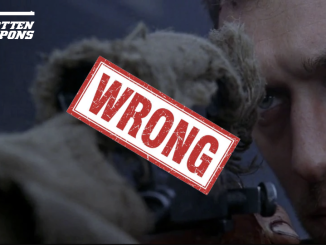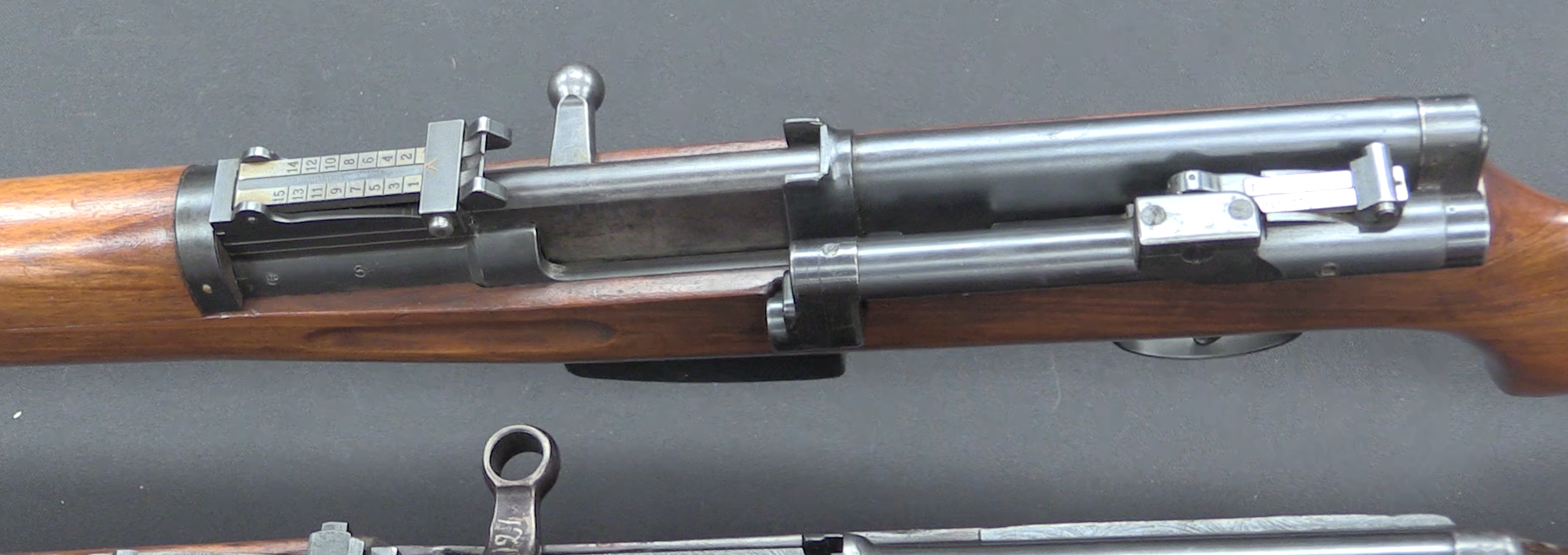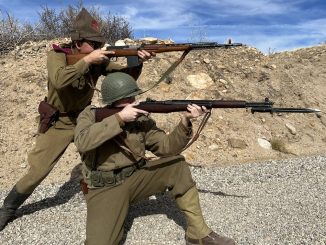After making the decision to mass produce a submachine gun, the Soviet Union adopted the Degtyarev PPD-38 and PPD-40, but this design was too expensive for the huge scale of production that the USSR intended. A new design was needed, and was put into development almost as soon as the PPD was entering production.
Shpagin won the design competition with the PPSh-41, a weapon which required virtually no lathe work at all. It was assembled from a combination of heavy-gauge stampings and simple milled parts, and it fit the Soviet requirements quite well. Shpagin retained the high rate of fire and large drum magazines from the PPD, and even had a semiauto selector switch in his submachine gun, a bit unusual in a weapon intended for minimum expense.
The drum magazines proved to be the weak point of the design, being only somewhat interchangeable between weapons and being rather complex to manufacture as well as bulky to carry and fairly easy to damage. A 35-round box magazine was introduced later on which ameliorated some of these issues, although not all of them. The PPSh-41 would go on to be deemed itself too complex, and supplemented by the PPS-43 submachine gun, although it was never fully replaced during World War Two. In addition to Soviet service, it would be copied and manufactured by several other nations.
Thanks to Marstar for letting me examine and shoot their PPSh-41!




In Call of Duty, every player grabs this whenever possible. Why? Ludicrous firepower!! And it’s lighter than the MG-42. Who wouldn’t want such a wonderful gun especially if under attack by Nazi zombies?
Gameplay mechanics aside, this is a case of too much rumbling for your rubles. Unless you have magazine loading device, prepare for hours of boredom before the shooting starts.
I know Shpagin and Degtyarov eventually collaborated on bigger things. But one thing the former did not do well was compete in the assault rifle program. He lost to Sudayev. The death of Sudayev later meant that Kalashnikov would take the lead. Kalashnikov’s prototype used many of Sudayev’s design features but got better after a year… how many avtomat designs could have been successful if politics didn’t play? And why can’t we find more information about the potentially successful runners-up?
“He lost to Sudayev. The death of Sudayev later meant that Kalashnikov would take the lead. Kalashnikov’s prototype used many of Sudayev’s design features but got better after a year… how many avtomat designs could have been successful if politics didn’t play?”
Politics? Where?
How many different weapons of same class you want to support?
Some competitors might be seen here:
http://vystrel.com.ua/2015/12/ne-kalashnikovym-edinym/
notice that designers were still unsure if what they have to do is “big sub-machine gun” or “diminutive light machine gun”
Some more competitors: http://forum.ohrana.ru/ognestrelnoe-oruzhie/thread557.html
The Simonov prototype looks interesting.
I knew it… I knew you are playing too many games!
That is why you are using those nasty names 🙂
All too true, my friend. At least I didn’t spout praises of trigger-happy-action-hero films. Rambo may look cool, but he has practically no story worthy of the screen other than just killing everything that isn’t American! I could be wrong.
I can see honesty in you comment; you are right afaikt. Thank you!
“Rambo may look cool, but he has practically no story worthy of the screen other than just killing everything that isn’t America”
For your information:
RAMBO movie is based on FIRST BLOOD by David Morrell
https://en.wikipedia.org/wiki/First_Blood_(novel)
which is much more anti-war than movie.
I am not expert at 1980s U.S. movies, so maybe someone other will elaborate on that topic.
A Rolls Royce compared to a STEN MkII or III
Even Korovin 1941 looks like luxury in comparison to STEN Mk III:
http://modernfirearms.net/en/submachine-guns/russia-submachine-guns/korovin-1941-eng/
At a glance, it looks like the simplified rear sight for the second iteration of the Shpagin PPSh41 came from the Tula-produced Korovin, no?
That thing is ugly… purposefully ugly, that is.
🙂
“That thing is ugly… purposefully ugly, that is.”
In fact this is early (alias more expensive) version, late (final) version was even simpler (more ugly if you want), see 1st photo from
http://fb.ru/article/163133/pistolet-pulemet-korovina-pistolet-pulemet-velikoy-otechestvennoy-voynyi
notice that it lack extendable stock
BTW: This article states that soldiers bacronymed ППШ as «пожиратель патронов Шпагина» that is “Shpagin cartridge eater”
You probably meant ZIL
https://www.carandclassic.co.uk/car/C669270
“was put into development almost as soon as the PPD was entering production.”
No. PPD in original form entered production in 1934, when PPSh was developed in 1940.
“Shpagin won the design competition with the PPSh-41, a weapon which required virtually no lathe work at all.”
The only competitor was design by Shpitalny (that of ShKAS fame)
http://warspot.ru/6530-drugoy-ppsh
It has some interesting features and was fair competitor, but was more costly in production.
“Shpagin retained the high rate of fire and large drum magazines from the PPD, and even had a semiauto selector switch in his submachine gun”
PPD has also fire-mode selector, it is reasonable to have such thing with weapon having that Rate-Of-Fire.
Also I am not sure if keeping Rate-Of-Fire was Shpagin intention, anyway Shpitalny sub-machine gun’ lower Rate-Of-Fire (791 rpm and 839 rpm measured in delivered samples) were deemed to be advantage.
“prepare for hours of boredom before the shooting starts”
Measured times of filling magazine, as taken during comparison of Shpagin and Shpitalny designs:
PPD drum magazine used in Shpagin sub-machine gun (capacity 71): 137 seconds
Shpitalny drum magazine (capacity 97): 108 seconds
I tell ya, this thing looks like anti-Thompson.
Did you see Thompson firsthand; how heavy, complex and clumsy it is?
“Thompson firsthand; how heavy, complex and clumsy it is?”
With all that being said, in defense of creation of General Thompson following must be noted:
– Thompson sub-machine gun is basically Great War era design, 20 year or so earlier
– Thompson has not knowledge of experience with sub-machine gun prior to designing his sub-machine gun, Shpagin has PPD as guiding light in terms of weight, shape, barrel length, Rate-of-Fire and similar
– Both used default automatic pistol cartridge then used, .45 Auto is simply physically larger and heavier than 7,62×25 thus magazine of same capacity will be probably lighter for 7,62×25
“PPSh-41 would go on to be deemed itself too complex, and supplemented by the PPS-43 submachine gun”
Shpagin also submitted design for new sub-machine gun: PPSh-2
Description in English: http://modernfirearms.net/en/submachine-guns/russia-submachine-guns/ppsh-2-eng/
Description in Russian why Sudayev design go into mass production and PPSh-2 not: http://warspot.ru/3402-pistolet-pulemyot-dlya-krasnoy-armii-shpagin-protiv-sudaeva
I sure hope Google-translate-from-Russian works! Looks very interesting…
Brilliant! Thanks very much! Very well explicated. One often reads about these Commie “burp guns” being crude, but from a distance, with the wooden stock furniture they look quite nice. Of course, thanks to the close-ups here at Marstar one can really see just how rough much of the pressed and stamped metal components are!
Postwar, of course, the PPSh41 served well into the period of Wars of National Liberation, where its simplicity and ruggedness commended it to any of a number of formerly colonized parts of the world… Already by 1961 huge numbers of these were supplied to the MNR militia in the Castro revolutionary regime in Cuba. Photos tend to show huge numbers of the Czech sa26 9x19mm SMG and sa24 9x19mm with fixed stock, and also the SHE “Modelo 52” 7.62x45mm self-loading rifle, but there were–indeed, still are–huge numbers of Shpagin SMGs.
In Vietnam, the Vietminh/ PAVN modified the PPSh41 and its Chi-com T50 knock-off into more closely resembling the French MAT-49 9mm SMG. The result was the so-called “K-50” that dispensed with the crude–but apparently effective?–muzzle brake, and added a wire collapsing stock a la mitraillette MAT, neither of which probably helped matters in terms of accuracy and controllability.
Looking forward to tomorrow’s field test! Sure hope Ian wore a hat with a visor or brim–or even helmet!–since the thing throws the brass straight up in the air for the most part…
Whoops! I meant SA23 fixed-stock and SA25. Those are the 9mm Czech SMGs, the 24 and 26 are the 7.62x25mm Tokarev-caliber versions.
This is SMG classic, hands down. This weapon served with many Soviet block countries, except with Czechoslovakia. They had apparently plenty of their own designs and prevalent cartridge in short postwar period (1945-50) was 9x19mm. Then came new line of vz.24/26 in ironically same calibre as PPSh.
Other than that we were extremely well familiar with this weapon from war memorials and war movies.
Why every american say p-p-es-eɪtʃ? You don’t say designer’s name Es-eɪtʃ-pagin, do you?
Because there is no “Sh” character in the Latin alphabet.
“S” and “H” are separate letters, so they are pronounced separately in initialisms.
The problem is initials being pronounced as individual letters here. Translation does not always give you the best answer if grammar and basic writing system are different… how does one pronounce the Cyrillic equivalent acronym for the designation?
“Translation does not always give you the best answer if grammar and basic writing system are different…”
This is NOT translation, this is transliteration.
If you want to use some standardized method then ISO-9.
ППШ -> PPŠ
IIRC, the correct Russian pronunciation is more like “pay-pay-shay”.
cheers
eon
Ah, just say Shpagin and be done with it. 🙂
“Burp gun”
But yea, in English the letters are P P S and H. So “Pee Pee Ess Aych” Not Pah-pah-shaw or “pay-pay-Shay” or what-have-you…
Shpagin is certainly a bit easier, I suppose. пп–obr. 1941
Vietnam took the PPSH-1941’s design and changed it into the K50 by replacing the single-piece stock with a pistol grip and M3-SMG-style wire stock wherein the stock is extended back for more side space in the magazine well if using the drum magazine and slid forward if using the box magazine.
Ian,
Your field strip could have gone one step more.
Remove the pin that connects the two halves of the gun.
The barrel slides out quickly and easily.
Quigley
I read somewhere that PPSh-equipped soldiers sometimes went into action with a drum in the gun and stick mags in the pouch. Maybe lugging a fresh drum out of your web gear was difficult and slow, esp. when the adrenaline was streaming. Or maybe just organizing two or more compatible drums was too much work out in the field? I imagine that some non-spec gunsmithing was sometimes applied to too-tight drums/box mags.
Early War Thompson users seem to have done the same thing.
From translated Soviet-era manual:
“Aimed fire can be out to 500 meters [!]. Firing rates for single-shot mode [semi-auto] is up to 30 rounds a minute, short-burst mode [2-4 shots] is as many as 70 rounds, and extended bursts [20-25 rounds] as many as 100 rounds a minute. Best results are achieved when firing on single-shot mode out to 300 meters, with short bursts out to 200 meters, and extended bursts out to 100 meters.
1. If the situation permits, after every 500-1,000 rounds, conduct a complete cleaning, removing the gun powder residue and congealed lubricant from the working parts, lightly oil, then reassemble the submachine gun. *If the combat situation does not permit a thorough cleaning, remove the magazine, place your selector switch on automatic fire and liberally pour kerosene over the bolt through the magazine well. Then pull the trigger and work the bolt fully back and forth to dilute the congealed lubricant and gun powder residue.* …
“Aimed fire can be out to 500 meters”
This reflect early type with sights scaled up to 500 meters (available distances: 50, 100, 150, 200, 250, 300, 350, 400, 450, 500 meters) which was later replaced by 100 / 200 meters sights.
This was copy of this https://en.wikipedia.org/wiki/Suomi_KP/-31
This is your hypothesis.
Now deliver evidence.